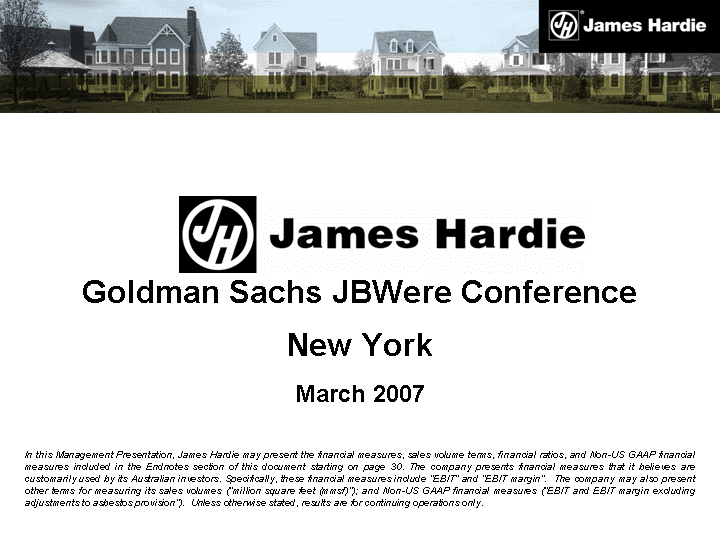

| Goldman Sachs JBWere Conference New York March 2007 In this Management Presentation, James Hardie may present the financial measures, sales volume terms, financial ratios, and Non-US GAAP financial measures included in the Endnotes section of this document starting on page 30. The company presents financial measures that it believes are customarily used by its Australian investors. Specifically, these financial measures include "EBIT" and "EBIT margin". The company may also present other terms for measuring its sales volumes ("million square feet (mmsf)"); and Non-US GAAP financial measures ("EBIT and EBIT margin excluding adjustments to asbestos provision"). Unless otherwise stated, results are for continuing operations only. |
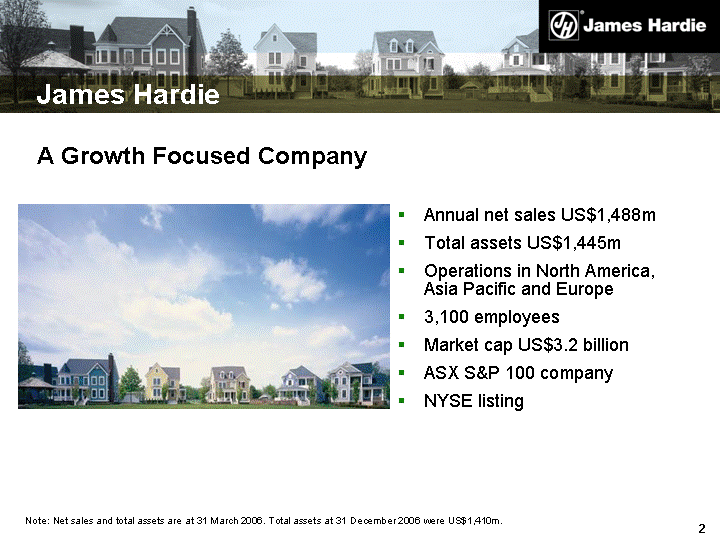
| James Hardie Annual net sales US$1,488m Total assets US$1,445m Operations in North America, Asia Pacific and Europe 3,100 employees Market cap US$3.2 billion ASX S&P 100 company NYSE listing Note: Net sales and total assets are at 31 March 2006. Total assets at 31 December 2006 were US$1,410m. A Growth Focused Company |
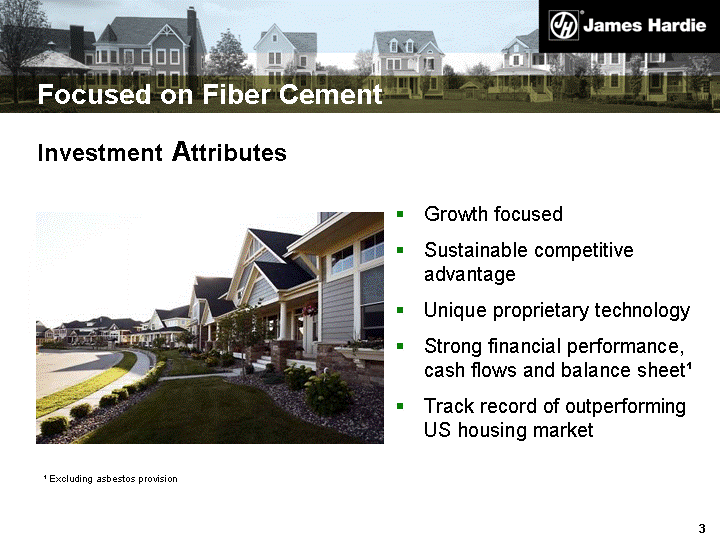
| Focused on Fiber Cement Growth focused Sustainable competitive advantage Unique proprietary technology Strong financial performance, cash flows and balance sheet1 Track record of outperforming US housing market Investment Attributes Investment Attributes 1 Excluding asbestos provision |
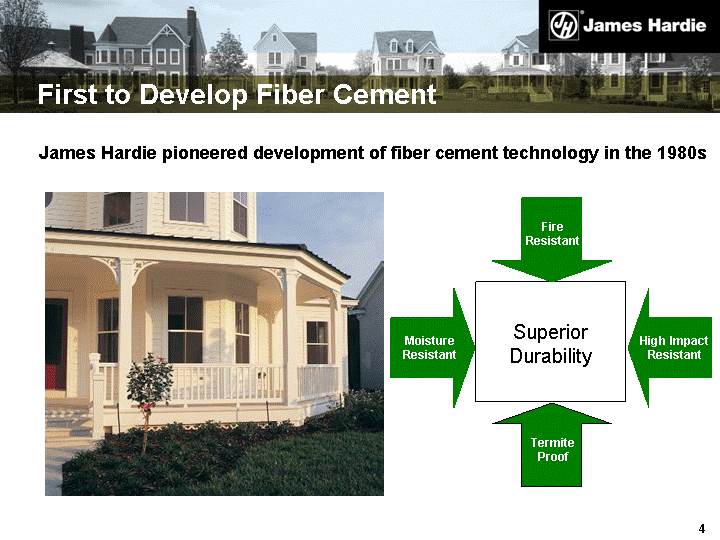
| First to Develop Fiber Cement James Hardie pioneered development of fiber cement technology in the 1980s James Hardie pioneered development of fiber cement technology in the 1980s Superior Durability Fire Resistant High Impact Resistant Moisture Resistant Termite Proof |
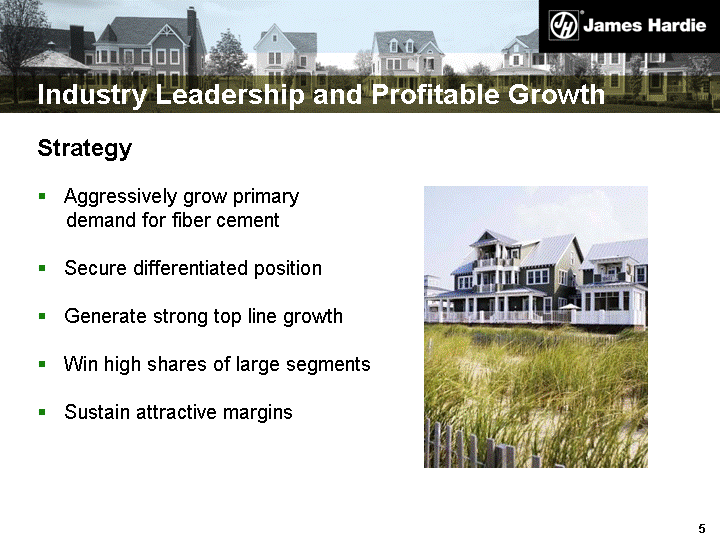
| Industry Leadership and Profitable Growth Aggressively grow primary demand for fiber cement Secure differentiated position Generate strong top line growth Win high shares of large segments Sustain attractive margins Strategy |
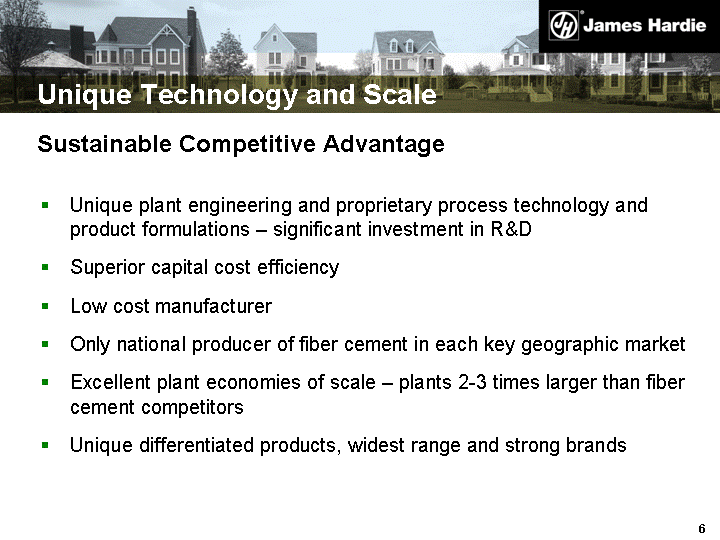
| Unique Technology and Scale Unique plant engineering and proprietary process technology and product formulations - significant investment in R&D Superior capital cost efficiency Low cost manufacturer Only national producer of fiber cement in each key geographic market Excellent plant economies of scale - plants 2-3 times larger than fiber cement competitors Unique differentiated products, widest range and strong brands Sustainable Competitive Advantage |

| Business Portfolio FY 20061 Total Identifiable Assets# Sales EBIT2,# USA Fiber Cement Established high growth/high return 79% 82% 95% Asia Pacific Fiber Cement Established high return 16% 16% 12% Other Potential growth opportunities (Pipes, Europe) 5% 2% (7%)2 1 At and for the fiscal year ended 31 March 2006 # Excludes General Corporate, Research and Development and Asbestos Provision 2 Includes Roofing and Chile - both discontinued in FY06 |
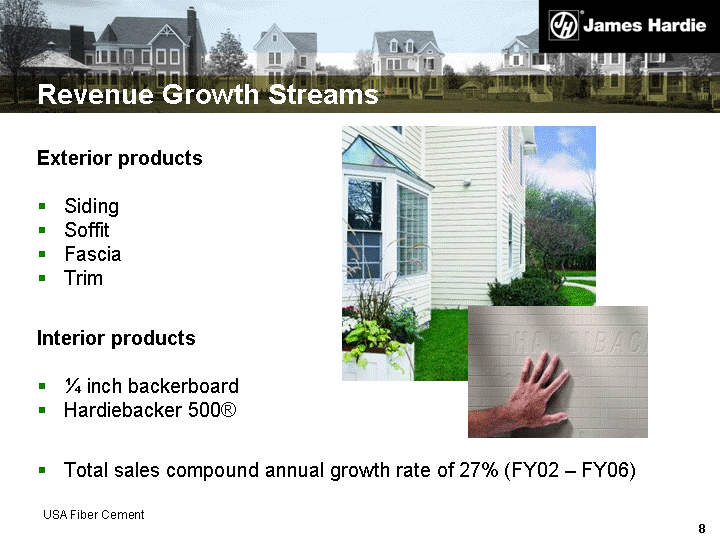
| Revenue Growth Streams Exterior products Siding Soffit Fascia Trim Interior products 1/4 inch backerboard Hardiebacker 500(r) Total sales compound annual growth rate of 27% (FY02 - FY06) USA Fiber Cement |
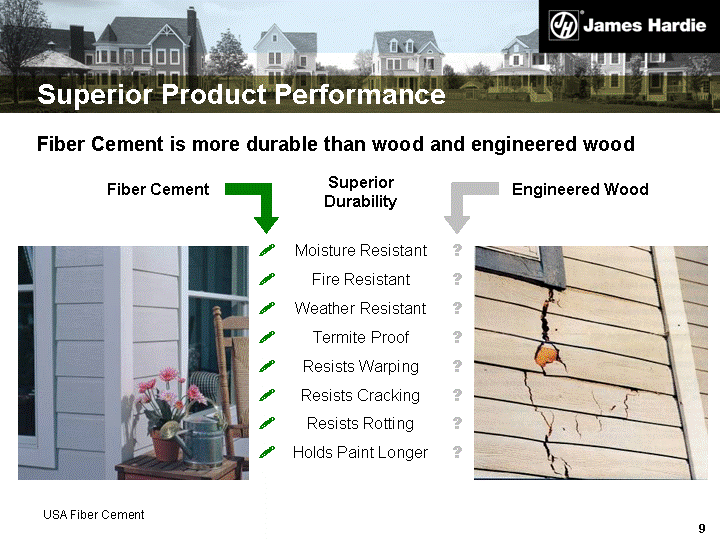
| Superior Product Performance Fiber Cement is more durable than wood and engineered wood Fiber Cement Superior Durability Moisture Resistant Fire Resistant Weather Resistant Termite Proof Resists Warping Resists Cracking Resists Rotting Holds Paint Longer ? ? ? ? ? ? ? ? ? ? ? ? ? ? ? ? Engineered Wood USA Fiber Cement |
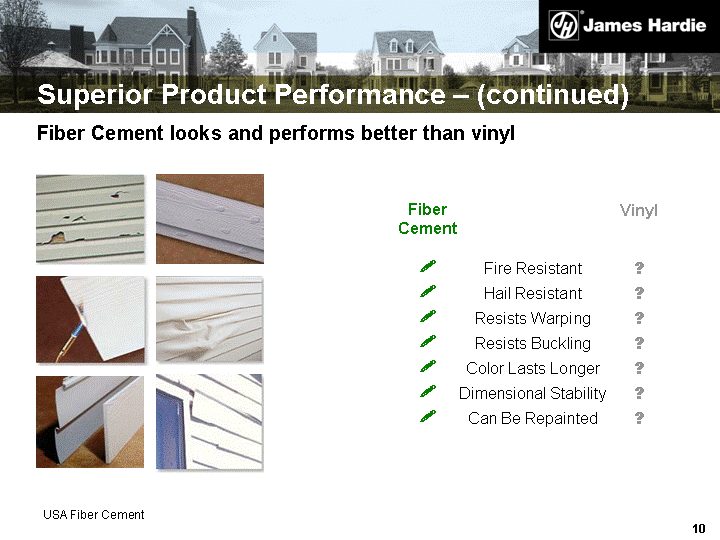
| Superior Product Performance - (continued) Fiber Cement looks and performs better than vinyl Vinyl Fire Resistant Hail Resistant Resists Warping Resists Buckling Color Lasts Longer Dimensional Stability Can Be Repainted ? ? ? ? ? ? ? ? ? ? ? ? ? ? Fiber Cement USA Fiber Cement |
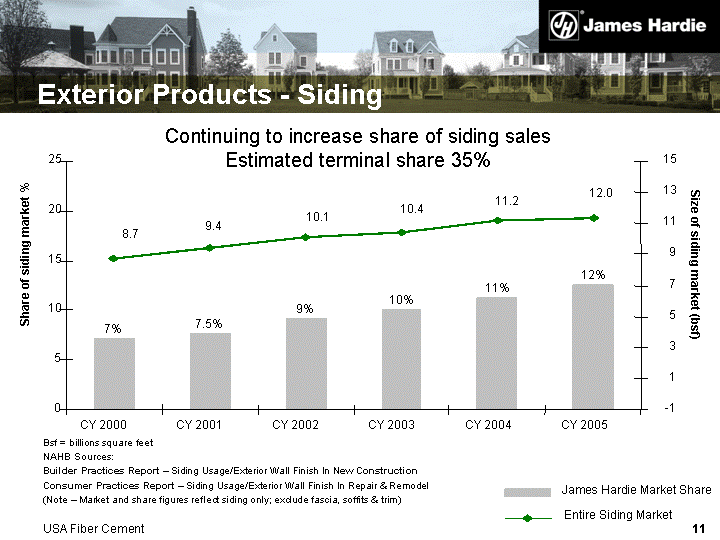
| Exterior Products - Siding Continuing to increase share of siding sales Estimated terminal share 35% Bsf = billions square feet NAHB Sources: Builder Practices Report - Siding Usage/Exterior Wall Finish In New Construction Consumer Practices Report - Siding Usage/Exterior Wall Finish In Repair & Remodel (Note - Market and share figures reflect siding only; exclude fascia, soffits & trim) James Hardie Market Share Entire Siding Market 7% 7.5% 9% 10% 11% 12% 8.7 9.4 10.1 10.4 11.2 12.0 0 5 10 15 20 25 CY 2000 CY 2001 CY 2002 CY 2003 CY 2004 CY 2005 Share of siding market % - -1 1 3 5 7 9 11 13 15 Size of siding market (bsf) USA Fiber Cement |
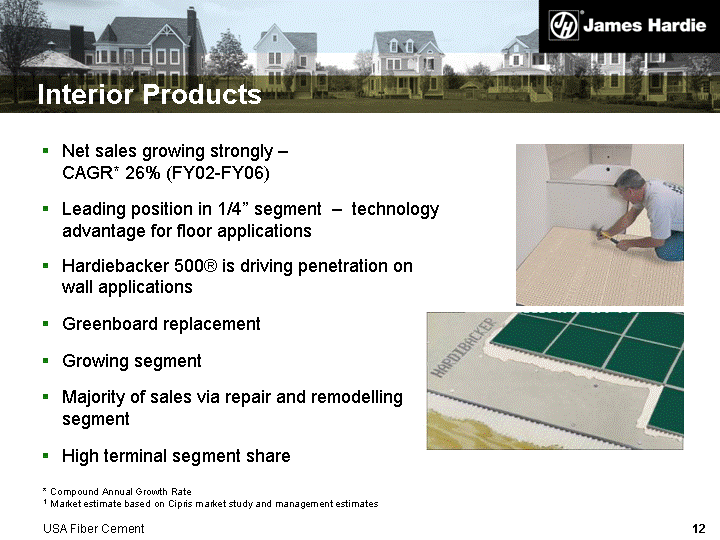
| Interior Products Net sales growing strongly - CAGR* 26% (FY02-FY06) Leading position in 1/4" segment - technology advantage for floor applications Hardiebacker 500(r) is driving penetration on wall applications Greenboard replacement Growing segment Majority of sales via repair and remodelling segment High terminal segment share * Compound Annual Growth Rate 1 Market estimate based on Cipris market study and management estimates USA Fiber Cement |
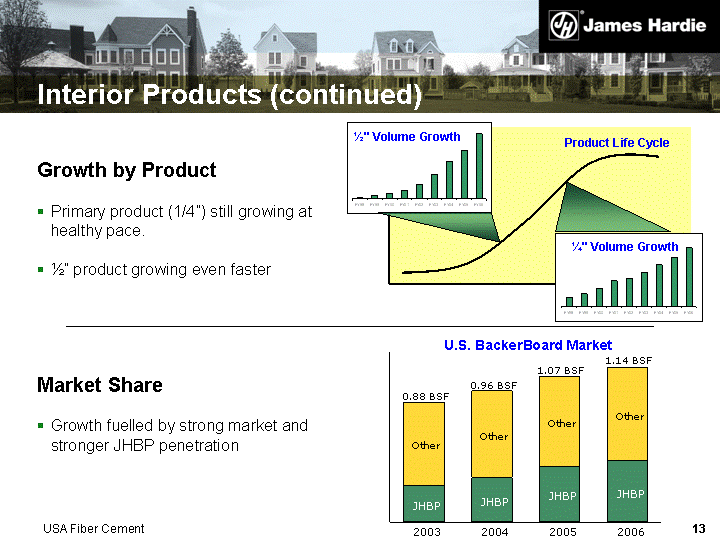
| Interior Products (continued) Product Life Cycle 1/4" Volume Growth 1/2" Volume Growth Growth by Product Primary product (1/4") still growing at healthy pace. 1/2" product growing even faster Market Share Growth fuelled by strong market and stronger JHBP penetration Other JHBP Other JHBP Other JHBP Other JHBP 2003 2004 2005 2006 0.88 BSF 0.96 BSF 1.07 BSF 1.14 BSF U.S. BackerBoard Market USA Fiber Cement |
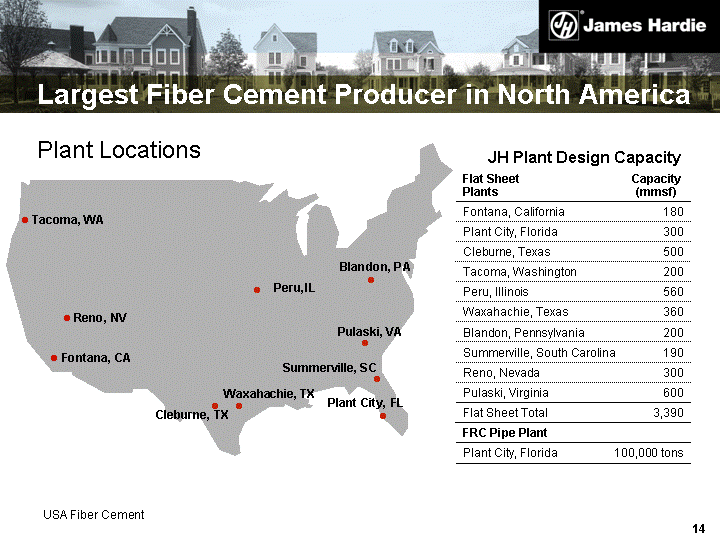
| Largest Fiber Cement Producer in North America Flat Sheet Plants Flat Sheet Plants Capacity (mmsf) Fontana, California Fontana, California 180 Plant City, Florida Plant City, Florida 300 Cleburne, Texas Cleburne, Texas 500 Tacoma, Washington Tacoma, Washington 200 Peru, Illinois Peru, Illinois 560 Waxahachie, Texas Waxahachie, Texas 360 Blandon, Pennsylvania Blandon, Pennsylvania 200 Summerville, South Carolina Summerville, South Carolina 190 Reno, Nevada Reno, Nevada 300 Pulaski, Virginia Pulaski, Virginia 600 Flat Sheet Total Flat Sheet Total 3,390 FRC Pipe Plant FRC Pipe Plant Plant City, Florida 100,000 tons 100,000 tons JH Plant Design Capacity Plant Locations USA Fiber Cement Tacoma, WA Plant City, FL Waxahachie, TX Cleburne, TX Peru, IL Blandon, PA Summerville, SC Pulaski, VA Reno, NV Fontana, CA |

| Low Cost Fiber Cement Producer USA Fiber Cement CAPITAL COST PER UNIT OF CAPACITY (US$/SF) 0.1 0.15 0.2 0.25 0.3 0.35 0.4 FY91 FY96 FY97 FY98 FY99 FY00 FY01 FY02 FY03 FY05 FY06 FY07 $US / SF PRODUCTION CAPACITY PER LINE 60 100 150 200 300 0.1 50.1 100.1 150.1 200.1 250.1 300.1 350.1 1990 1994 1998 2001 2000 MMSF |
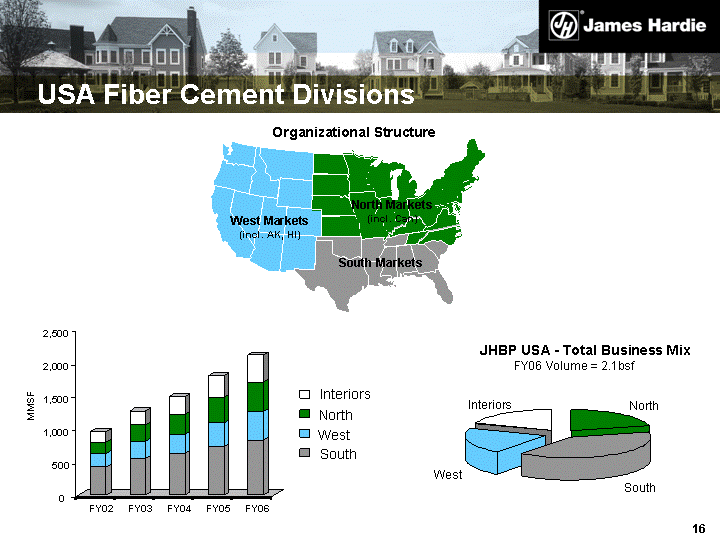
| USA Fiber Cement Divisions Organizational Structure West Markets (incl. AK, HI) North Markets (incl. Can) South Markets Interiors North West 0 500 1,000 1,500 2,000 2,500 MMSF FY02 FY03 FY04 FY05 FY06 South West JHBP USA - Total Business Mix FY06 Volume = 2.1bsf North South Interiors |
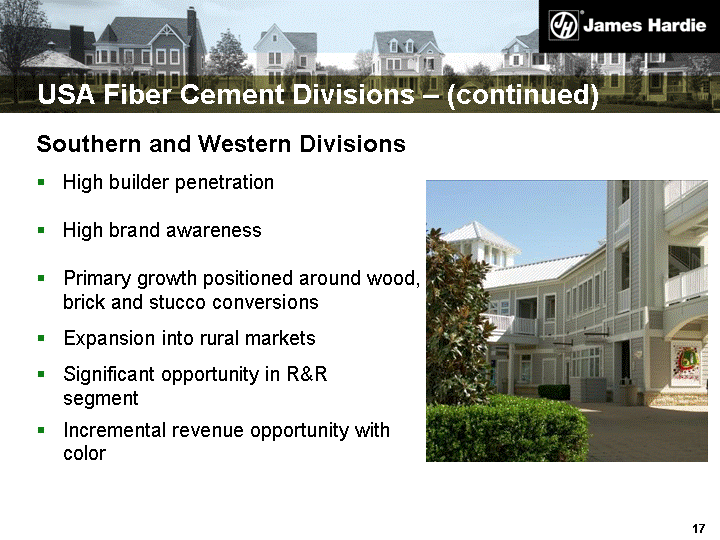
| USA Fiber Cement Divisions - (continued) Southern and Western Divisions High builder penetration High brand awareness Primary growth positioned around wood, vinyl, brick and stucco conversions Expansion into rural markets Significant opportunity in R&R segment Incremental revenue opportunity with color |

| USA Fiber Cement Divisions Northern Division Approx. 50% of new housing sales Accounts for 25% of USA Fiber Cement sales Penetrating regions where vinyl is dominant siding material Focus on majority color penetration Estimated terminal share of 30% |
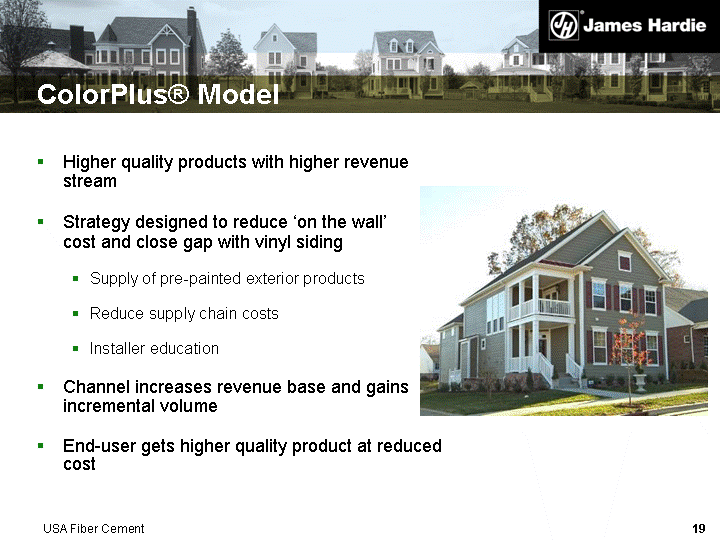
| ColorPlus(r) Model Higher quality products with higher revenue stream Strategy designed to reduce 'on the wall' cost and close gap with vinyl siding Supply of pre-painted exterior products Reduce supply chain costs Installer education Channel increases revenue base and gains incremental volume End-user gets higher quality product at reduced cost USA Fiber Cement |
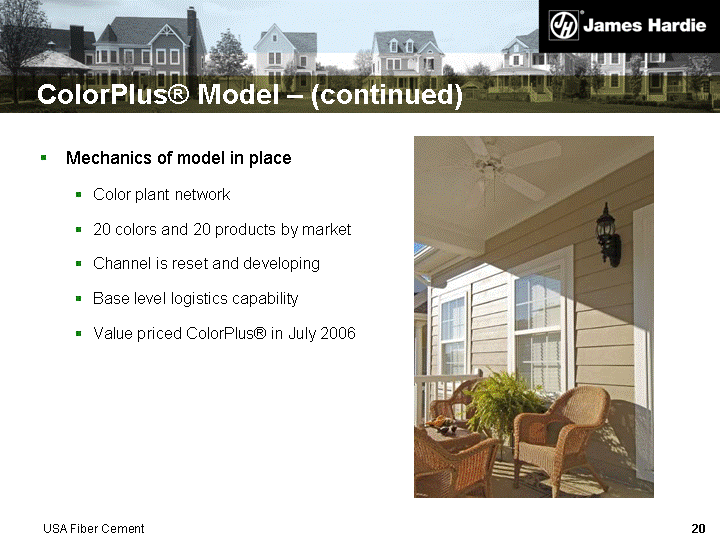
| ColorPlus(r) Model - (continued) Mechanics of model in place Color plant network 20 colors and 20 products by market Channel is reset and developing Base level logistics capability Value priced ColorPlus(r) in July 2006 USA Fiber Cement |
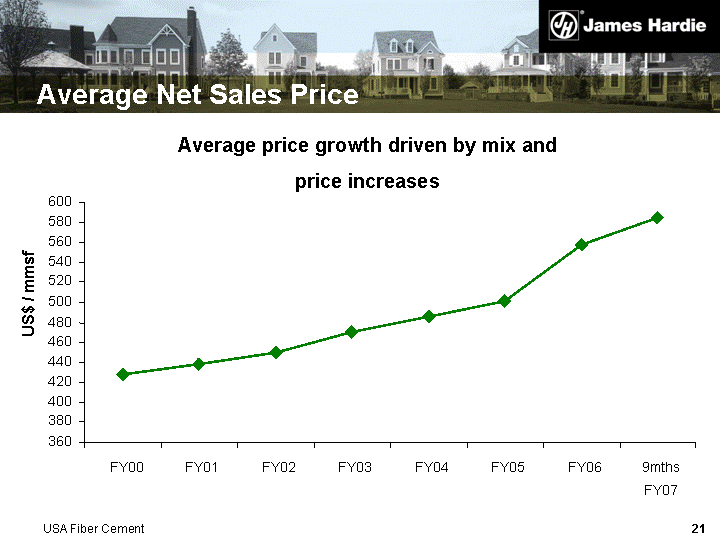
| Average Net Sales Price Average price growth driven by mix and price increases 360 380 400 420 440 460 480 500 520 540 560 580 600 FY00 FY01 FY02 FY03 FY04 FY05 FY06 9mths FY07 US$ / mmsf USA Fiber Cement |
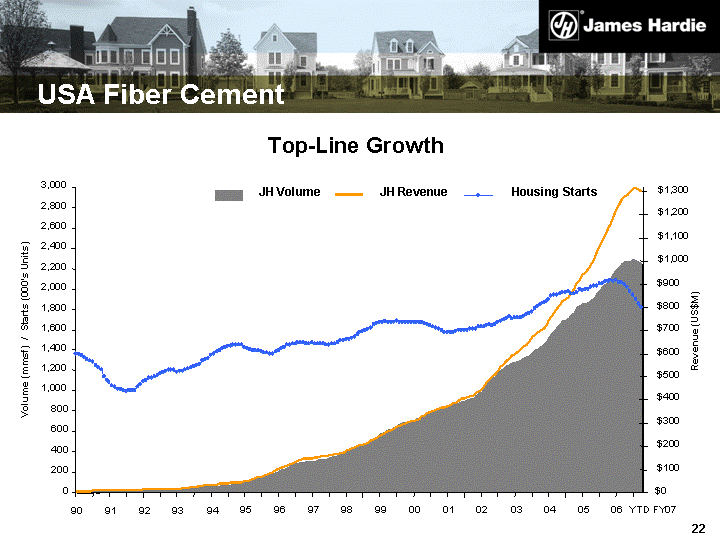
| USA Fiber Cement Top-Line Growth 0 200 400 600 800 1,000 1,200 1,400 1,600 1,800 2,000 2,200 2,400 2,600 2,800 3,000 90 91 92 93 94 95 96 97 98 99 00 01 02 03 04 05 Volume (mmsf) / Starts (000's Units) $0 $100 $200 $300 $400 $500 $600 $700 $800 $900 $1,000 $1,100 $1,200 $1,300 Revenue (US$M) JH Volume JH Revenue Housing Starts 06 YTD FY07 |
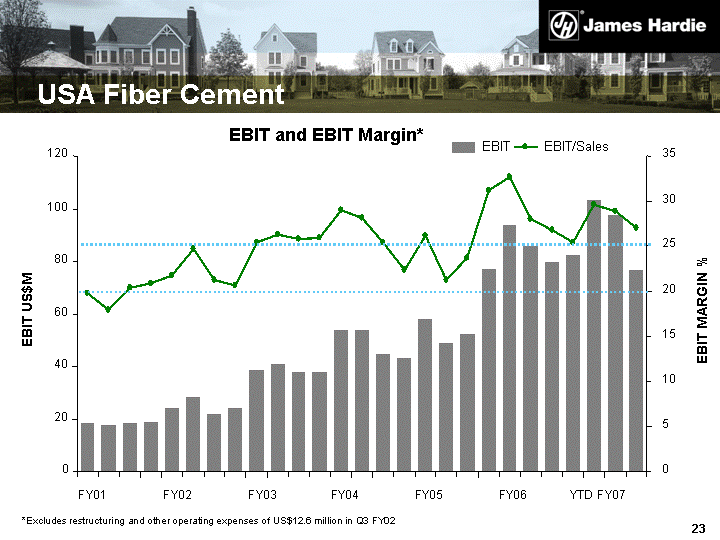
| USA Fiber Cement *Excludes restructuring and other operating expenses of US$12.6 million in Q3 FY02 EBIT and EBIT Margin* 0 20 40 60 80 100 120 FY01 FY02 FY03 FY04 FY05 FY06 YTD FY07 EBIT US$M 0 5 10 15 20 25 30 35 EBIT MARGIN % EBIT EBIT/Sales |
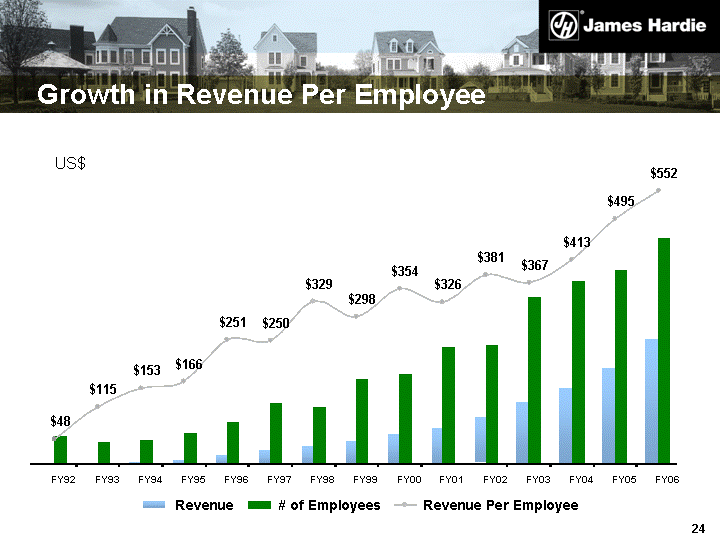
| Growth in Revenue Per Employee $552 $495 $48 $115 $153 $166 $251 $250 $329 $298 $354 $326 $381 $367 $413 FY92 FY93 FY94 FY95 FY96 FY97 FY98 FY99 FY00 FY01 FY02 FY03 FY04 FY05 FY06 Revenue # of Employees Revenue Per Employee US$ |
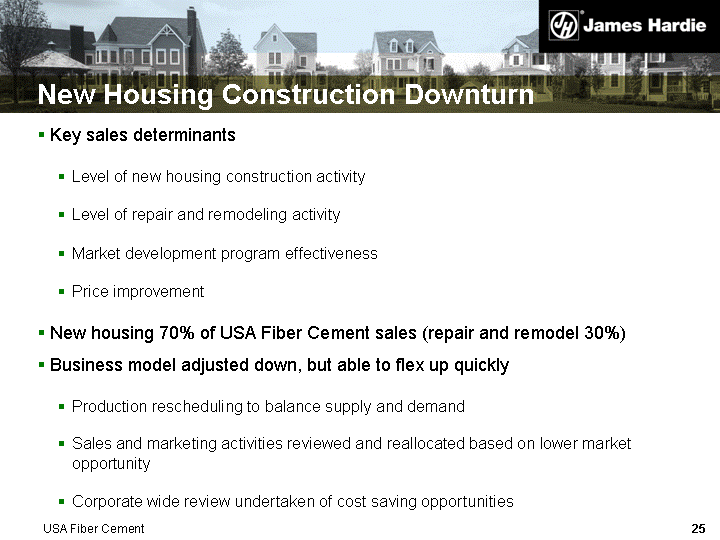
| New Housing Construction Downturn Key sales determinants Level of new housing construction activity Level of repair and remodeling activity Market development program effectiveness Price improvement New housing 70% of USA Fiber Cement sales (repair and remodel 30%) Business model adjusted down, but able to flex up quickly Production rescheduling to balance supply and demand Sales and marketing activities reviewed and reallocated based on lower market opportunity Corporate wide review undertaken of cost saving opportunities USA Fiber Cement |
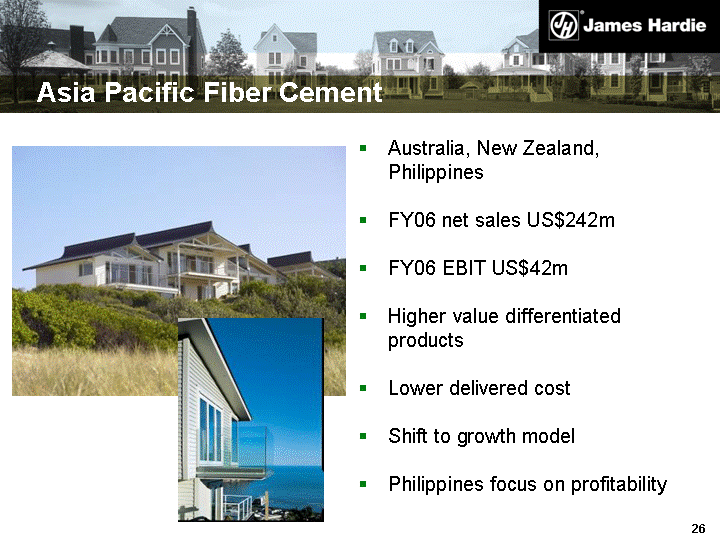
| Asia Pacific Fiber Cement Australia, New Zealand, Philippines FY06 net sales US$242m FY06 EBIT US$42m Higher value differentiated products Lower delivered cost Shift to growth model Philippines focus on profitability |
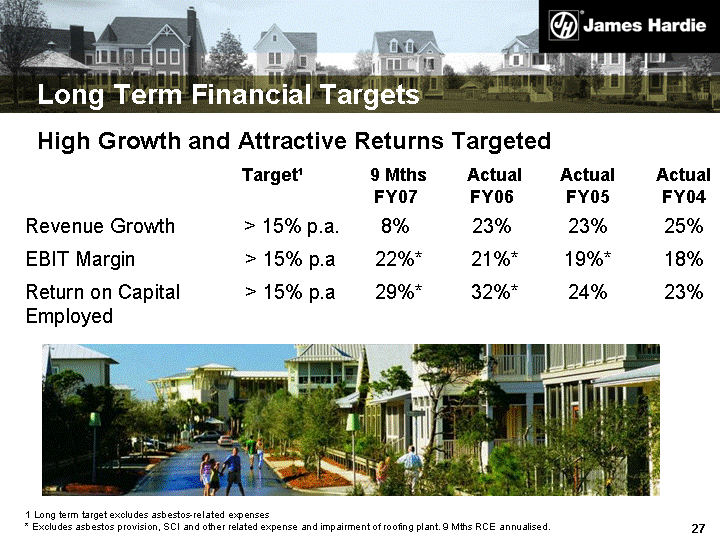
| High Growth and Attractive Returns Targeted Long Term Financial Targets Target1 9 Mths FY07 Actual FY06 Actual FY05 Actual FY04 Revenue Growth > 15% p.a. 8% 23% 23% 25% EBIT Margin > 15% p.a 22%* 21%* 19%* 18% Return on Capital Employed > 15% p.a 29%* 32%* 24% 23% 1 Long term target excludes asbestos-related expenses * Excludes asbestos provision, SCI and other related expense and impairment of roofing plant. 9 Mths RCE annualised. |

| Asbestos Compensation Arrangement Security holders voted in favor of company's voluntary funding proposal on February 7, 2007 Binding agreement with New South Wales Government for 40+ years Funding is for Australian based personal injury claims against certain former Australian subsidiary companies where personal injury was caused in Australia Annual contributions made by James Hardie to a separate entity, Asbestos Injury Compensation Fund (AICF) Annual contribution is the lesser of: Actuarial estimate for next 3 year period, plus operating expenses for next year less assets of the AICF A percentage of net operating cash flow - initial cap 35%, with phased reduction to 10% possible over time Actuarial estimate as at 30 September 2006 A$1.55bn (net present value). Please refer to the company's website for full details on this funding arrangement and for information on proceedings filed by the Australian Securities and Investments Commission in February 2007 concerning certain former officers and directors and the company in connection with asbestos related matters |

| Summary We have a strong, well established, growth focused and high return business We have a sustainable competitive advantage Our model for continued strong growth is based on: Large market opportunity Superior value proposition Proprietary and/or protected technology Upsides due to current R&D investments Significant organizational advantages Focused strategy and organizational effort Scale The company is in a sound financial position Accounting results subject to volatility - FX impact on A$ asbestos provision |
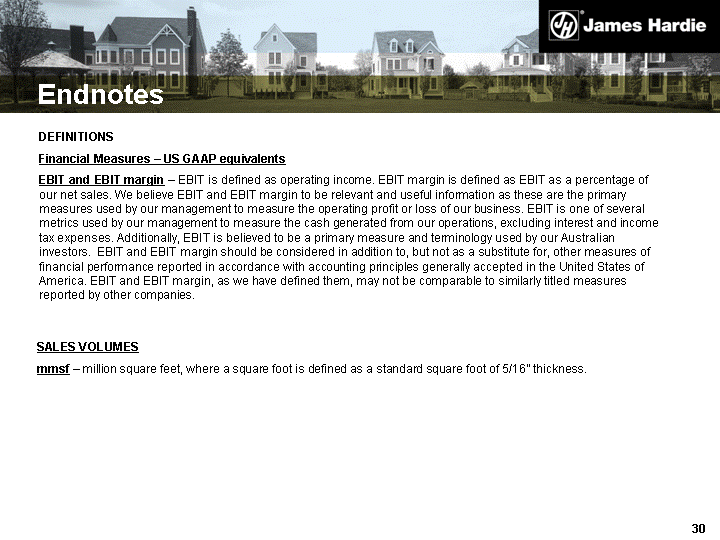
| Endnotes DEFINITIONS Financial Measures - US GAAP equivalents EBIT and EBIT margin - EBIT is defined as operating income. EBIT margin is defined as EBIT as a percentage of our net sales. We believe EBIT and EBIT margin to be relevant and useful information as these are the primary measures used by our management to measure the operating profit or loss of our business. EBIT is one of several metrics used by our management to measure the cash generated from our operations, excluding interest and income tax expenses. Additionally, EBIT is believed to be a primary measure and terminology used by our Australian investors. EBIT and EBIT margin should be considered in addition to, but not as a substitute for, other measures of financial performance reported in accordance with accounting principles generally accepted in the United States of America. EBIT and EBIT margin, as we have defined them, may not be comparable to similarly titled measures reported by other companies. SALES VOLUMES mmsf - million square feet, where a square foot is defined as a standard square foot of 5/16" thickness. |
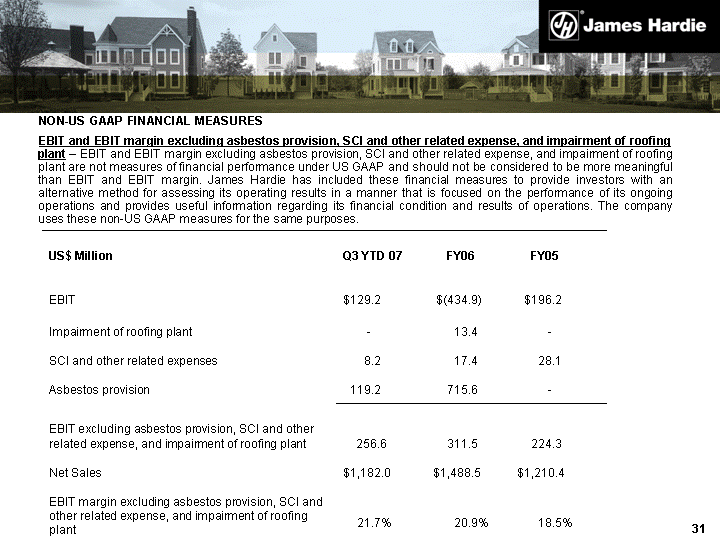
| NON-US GAAP FINANCIAL MEASURES EBIT and EBIT margin excluding asbestos provision, SCI and other related expense, and impairment of roofing plant - EBIT and EBIT margin excluding asbestos provision, SCI and other related expense, and impairment of roofing plant are not measures of financial performance under US GAAP and should not be considered to be more meaningful than EBIT and EBIT margin. James Hardie has included these financial measures to provide investors with an alternative method for assessing its operating results in a manner that is focused on the performance of its ongoing operations and provides useful information regarding its financial condition and results of operations. The company uses these non-US GAAP measures for the same purposes. US$ Million Q3 YTD 07 FY06 FY05 EBIT $129.2 $(434.9) $196.2 Impairment of roofing plant SCI and other related expenses Asbestos provision - 8.2 119.2 13.4 17.4 715.6 - 28.1 - EBIT excluding asbestos provision, SCI and other related expense, and impairment of roofing plant 256.6 311.5 224.3 Net Sales $1,182.0 $1,488.5 $1,210.4 EBIT margin excluding asbestos provision, SCI and other related expense, and impairment of roofing plant 21.7% 20.9% 18.5% |
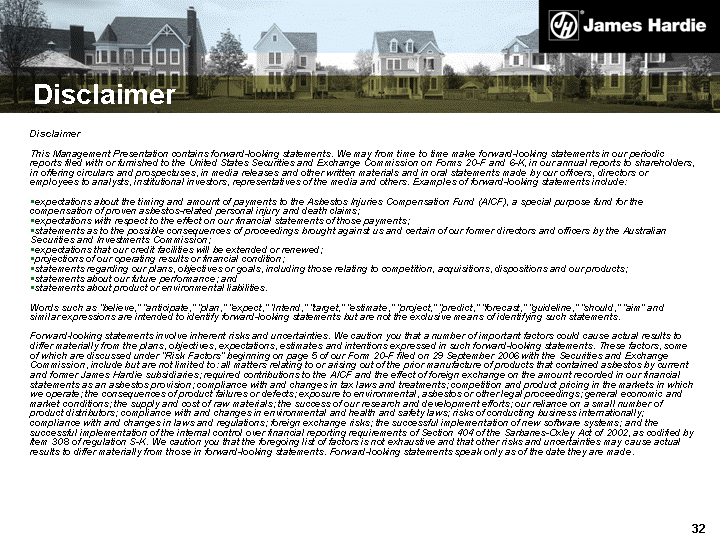
| Disclaimer Disclaimer This Management Presentation contains forward-looking statements. We may from time to time make forward-looking statements in our periodic reports filed with or furnished to the United States Securities and Exchange Commission on Forms 20-F and 6-K, in our annual reports to shareholders, in offering circulars and prospectuses, in media releases and other written materials and in oral statements made by our officers, directors or employees to analysts, institutional investors, representatives of the media and others. Examples of forward-looking statements include: expectations about the timing and amount of payments to the Asbestos Injuries Compensation Fund (AICF), a special purpose fund for the compensation of proven asbestos-related personal injury and death claims; expectations with respect to the effect on our financial statements of those payments; statements as to the possible consequences of proceedings brought against us and certain of our former directors and officers by the Australian Securities and Investments Commission; expectations that our credit facilities will be extended or renewed; projections of our operating results or financial condition; statements regarding our plans, objectives or goals, including those relating to competition, acquisitions, dispositions and our products; statements about our future performance; and statements about product or environmental liabilities. Words such as "believe," "anticipate," "plan," "expect," "intend," "target," "estimate," "project," "predict," "forecast," "guideline," "should," "aim" and similar expressions are intended to identify forward-looking statements but are not the exclusive means of identifying such statements. Forward-looking statements involve inherent risks and uncertainties. We caution you that a number of important factors could cause actual results to differ materially from the plans, objectives, expectations, estimates and intentions expressed in such forward-looking statements. These factors, some of which are discussed under "Risk Factors" beginning on page 5 of our Form 20-F filed on 29 September 2006 with the Securities and Exchange Commission, include but are not limited to: all matters relating to or arising out of the prior manufacture of products that contained asbestos by current and former James Hardie subsidiaries; required contributions to the AICF and the effect of foreign exchange on the amount recorded in our financial statements as an asbestos provision; compliance with and changes in tax laws and treatments; competition and product pricing in the markets in which we operate; the consequences of product failures or defects; exposure to environmental, asbestos or other legal proceedings; general economic and market conditions; the supply and cost of raw materials; the success of our research and development efforts; our reliance on a small number of product distributors; compliance with and changes in environmental and health and safety laws; risks of conducting business internationally; compliance with and changes in laws and regulations; foreign exchange risks; the successful implementation of new software systems; and the successful implementation of the internal control over financial reporting requirements of Section 404 of the Sarbanes-Oxley Act of 2002, as codified by Item 308 of regulation S-K. We caution you that the foregoing list of factors is not exhaustive and that other risks and uncertainties may cause actual results to differ materially from those in forward-looking statements. Forward-looking statements speak only as of the date they are made. |